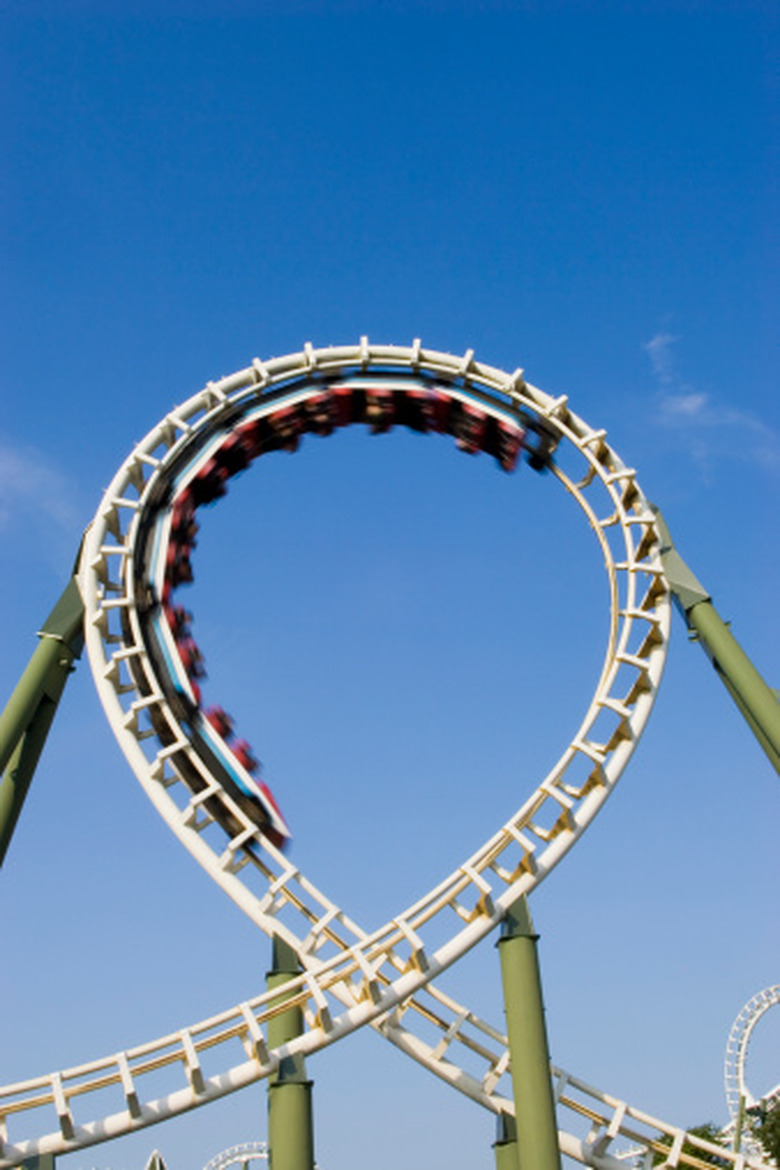Science Facts About Roller Coasters For Kids
Roller coasters are getting bigger, faster and scarier every year. Superman, the Escape at Six Flags Magic Mountain in California tops out at 100 mph. The roller coaster cars plummet on a 415-foot drop, providing an instant adrenalin rush to riders. Roller coaster designers use their knowledge of biology, physics and psychology to create safe, yet exciting rides. Next time you board a roller coaster with your friends, educate and thrill them with a few scientific facts.
G-Force Facts
G-Force Facts
G-force is the force of gravity upon a body as it accelerates. On the Revolution roller coaster at Six Flags Magic Mountain in Valencia, California, riders experience more G-force than the astronauts do during a shuttle launch, according to Carnegie Magazine. The roller coaster gives its passengers a G-force of 4.9, while a shuttle launch provides a G-force of 3.4.
Einstein's Roller Coaster Observation
Einstein's Roller Coaster Observation
Albert Einstein said roller coasters are perfect examples of energy conservation in a mechanical system in "The Evolution of Physics." In this book, co-written by Leopold Infeld, Einstein explained that roller coasters convert potential energy into kinetic energy, and depend solely on gravity and momentum. Potential energy is the energy possessed by objects with mass within a force field. Kinetic energy is the energy of a body in motion. Kinetic energy equals half the mass of the body times the square of its speed, so the faster the object moves, the greater the kinetic energy.
Roller Coaster Psychology
Roller Coaster Psychology
The emotions you feel as you wait in line to ride a roller coaster are due in part to a process known as the "fight or flight response." Your mind is weighing the danger it perceives and your options for dealing with that danger. This can cause you to feel excited, stressed, afraid, defensive, aggressive or a combination of these and other emotions. This psychological experience triggers a physical response, too.
Biological Responses to Roller Coasters
Biological Responses to Roller Coasters
The "fight or flight response" results in a variety of biological responses that can differ from one person to the next. Your heart rate may change dramatically. You might sweat a bit more than usual, feel dizzy or disoriented. Your breathing rate can vary and your muscles might tense. These changes may feel good, if you are a thrill-seeker. If you are not, they may be terrifying.
Motion sickness is generally the culprit when you feel nauseated or vomit while riding a roller coaster. Motion sickness is thought to be caused when a person's eyes and the balance centers in their ears disagree on what is taking place. This confuses the body and can result in dizziness, nausea and vomiting.
References
- ScienceFocus; The Thrill Engineers; Andy Ridgway
- University of Alaska-Fairbanks; Roller Coaster Science: The Science Behind the Thrills; Shawna Sastamoinen; 2002
- "The Evolution of Physics: From Early Concepts to Relativity and Quanta; Albert Einstein, et al.; 1966
- Physics Classroom: Roller Coaster G-Forces
Cite This Article
MLA
Flood, Colleen. "Science Facts About Roller Coasters For Kids" sciencing.com, https://www.sciencing.com/science-roller-coasters-kids-8566349/. 24 April 2017.
APA
Flood, Colleen. (2017, April 24). Science Facts About Roller Coasters For Kids. sciencing.com. Retrieved from https://www.sciencing.com/science-roller-coasters-kids-8566349/
Chicago
Flood, Colleen. Science Facts About Roller Coasters For Kids last modified August 30, 2022. https://www.sciencing.com/science-roller-coasters-kids-8566349/
